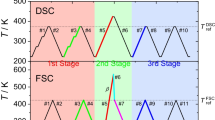Abstract
The thermodynamics data of crystalline states of two representative components in blood sugar, d-glucose and d-fructose, are significant in researching artificial synthesis and composition transformation in vivo. The heat capacities of d-glucose and d-fructose over a temperature range of 1.9–300 K were measured and calculated by the heat capacity measurement module of physical property measurement system (PPMS). The heat capacities of two compounds increased steadily with temperature, showing a smooth curve without any thermal anomalies. The heat capacity of d-glucose is greater than that of d-fructose in the range of 0 K < T < 80 K, which is smaller than that of d-fructose between 80 and 300 K. Based on the lattice vibration mode, factors of generating the difference heat capacity data between the two isomers were investigated. Additionally, the heat capacity data were fitted by low-temperature heat capacity theoretical model. The thermodynamic data that molar entropy change and molar enthalpy change over the temperature range of 0–300 K were calculated. The standard molar entropy of d-glucose and d-fructose at 298.15 K was calculated by heat capacity fitting to be 214.64 and 217.56 J K−1 mol−1, all with an error of 0.21.





Similar content being viewed by others
References
Kong FY. Sugar chemistry. Beijing: Science Press; 2005.
Hoyer S. Memory function and brain glucose metabolism. Pharmacopsychiatry. 2003;36(1):S62–S6767.
Yu CC, Yuan M, Yang HY, et al. P-glycoprotein on blood-brain barrier plays a vital role in fentanyl brain exposure and respiratory toxicity in rats. Toxicol Sci. 2018;164:353–62.
Saltiel AR, Kahn CR. Insulin signalling and the regulation of glucose and lipid metabolism. Nature. 2001;414(6865):799–806.
Numora M, Kawahara Y. Role of the sweet taste receptor in glucose metabolism: no sweet for diabetes. J Pharmaceut Soc Jpn. 2015;135(6):763–7.
Boerio-Goates J. Heat-capacity measurements and thermodynamic functions of crystalline α-d-glucose at temperatures from 10 to 340 K. J Chem Thermodyn. 1991;23(5):403–9.
Yamamura Y, Iwagaki S, Hishida M, et al. Heat capacity and standard thermodynamic functions of three ketohexoses in monosaccharides including rare sugars: d-fructose, d-psicose, and d-tagatose. J Chem Thermodyn. 2018;131:420–30.
Shi Q, Boerio-Goates J, Woodfield BF. An improved technique for accurate heat capacity measurements on powdered samples using a commercial relaxation calorimeter. J Chem Thermodyn. 2011;43(8):1263–9.
Quan S, Zhang L, Schlesinger ME, et al. Low temperature heat capacity study of Fe3PO7 and Fe4(P2O7)3. J Chem Thermodyn. 2013;62(3):86–91.
Gopal ESR. Specific heats at low temperatures. New York: Plenum Press; 1966.
Shi Q, Zhang L, Schlesinger ME, et al. Low temperature heat capacity Study of Fe (PO3)3 and Fe2P2O7. J Chem Thermodyn. 2013;61:51–7.
Shi Q, Park TJ, Schliesser J, et al. Low temperature heat capacity study of Ba2TiSi2O8 and Sr2TiSiO8. J Chem Thermodyn. 2014;72:77–84.
Shi Q, Zhang L, Schlesinger ME, et al. Low temperature heat capacity study of Fe3P7 and Fe4(P2O7)3. J Chem Thermodyn. 2013;62(3):86–91.
Phillips NE. Low-temperature heat capacity of metals. C R C Crit Rev Solid State Sci. 1971;2(4):467–553.
Snow CL, Shi Q, Boerio-Goates J, et al. Heat capacity, third-law entropy, and low-temperature physical behavior of bulk hematite(α-Fe2O3). J Chem Thermodyn. 2010;42(9):1136–41.
Pet’kov VI, Shipilov AS, Markin AV, et al. Standard thermodynamic functions of crystalline arsenate Mg0.5Zr2(AsO4)3 in the range from T → 0 to 670 K. Russ J Phys Chem A. 2018;92(4):646–52.
Kondrat’eva ON, Tyurin AV, Nikiforova GE, et al. Heat capacity and thermodynamic properties of Mg(Fe0.6Ga0.4)2O4, in the 0–800 K temperature range. Russ J Inorg Chem. 2017;62(2):204–10.
Acknowledgements
This work was supported by the National Natural Science Foundation of China (Grant No. 21802014) and the Fundamental Research Funds for the Central Universities (Grant No. 017192414).
Author information
Authors and Affiliations
Corresponding author
Additional information
Publisher's Note
Springer Nature remains neutral with regard to jurisdictional claims in published maps and institutional affiliations.
Rights and permissions
About this article
Cite this article
Xue, P., Tan, F., Liu, H. et al. Low-temperature heat capacity of d-glucose and d-fructose. J Therm Anal Calorim 145, 3235–3242 (2021). https://doi.org/10.1007/s10973-020-09849-8
Received:
Accepted:
Published:
Issue Date:
DOI: https://doi.org/10.1007/s10973-020-09849-8



